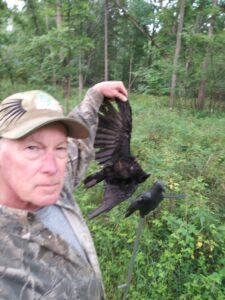Gettin’ Ready for Crows
By Glen Wunderlich
Outdoor Columnist
Member Professional Outdoor Media Association
A friend asked me last week what I was doing now that deer hunting season was over. “Gettin’ ready for crow season,” was my immediate response. He laughed a bit and then said, “How do you get ready for crow season?”, somewhat inquisitive and somewhat as if he figured I couldn’t actually be doing anything to prepare. My “Loadin’ ammo” retort seemed to wipe that smirk off his face but most people still think there’s something wrong with looking forward to hunting crows. Now, I’m not talking about animal rightists, who are opposed to any form of hunting; the average hunter doesn’t get it either – unless, of course, he’s seen it rain crows.
I had never been very successful at bagging the crafty troublemakers but results began to improve when I re-read a segment of Bert Popowski’s “Crow and Varmint Hunting Bible” relating to shot size. One would think that heavier shot would carry farther and that magnum loads would do the sky-busting trick best, but it never worked for me. We’d drop one here and there but for the most part, the crows would get the last laugh. Bert indicated that it was a common fallacy for hunters to use shot that was too heavy, and for crows, even loads designed for pheasant were not optimum. Since Bert used number 9 shot, I decided to give it a try and that’s when results began to change.
What really surprised me was the length of some of the kills. Of course, that got me thinking. If 9 shot was capable of long-range success, bigger would be better. Not bigger in shot size but bigger in payload. So, this season our crazy crow club has graduated to magnum, home-brewed 3-inch bird blasting bombs carrying 1 7/8 ounces of shot.
We had to hand load the shells, because no store (or ammo manufacturer) has any demand for such a concoction. And, that’s understandable. The shot size is too small for larger birds, such as pheasant or turkey, and the magnum wallop would tenderize partridge and woodcock beyond recognition. However, since we weren’t interested in deep fried crowquettes, why not give it a shot?
With all the components gathered, I headed over to Shawn Weaver’s house with Matt Arnold (the other members of our crow-crazy clan) to manufacture our own brand of perforating punch. In short order, the assembly mission was complete and it was time for testing.
Although manufacturers do not agree on what pattern percentage constitutes a particular degree of choke (ratio of total shot in a load versus total shot within a 30-inch circle at 40 yards), there is agreement that full choke patterns fall within 65 to 75 percent. Since our pet brand contained an astounding 1097 pellets, patterning would be not be an easy chore but, since I wasn’t content to rely on what was stamped on my choke tube, it had to be done for reference.
Back home, another crow buster, Joe Reynolds and I, drew a crow outline on a large sheet of paper and stapled it to the backstop at 40 yards. One blast and it was back to the garage to begin the arduous task of counting holes. We sectioned off the target and a half hour later, when the counting was complete, a total of 676 pellets had hit the 30-inch circle making for 62 percent of the load. Although it was a little less than I had hoped for, the pattern density indicated the shot was a bit high and that some of the shot missed the paper. More interesting, however, was the number of holes in our flying crow outline: 106! Since only about 4 pellets are necessary to kill a crow, maybe it’s a bit of overkill. Then again, maybe there’s no such thing when it comes to crows.
More testing will be performed at extended ranges but it appears we may be on to something. Just don’t let any crows know what we have in store for them in a few weeks.






